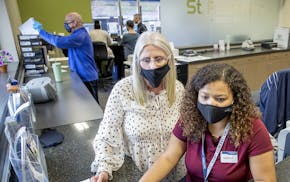What makes a person go "green"? For Micaela Preston of Minneapolis, it was motherhood. As a mother of two she's buying more stuff than ever and finds herself caring about the impact of those items on the environment. It's about the food she buys, avoiding the toxins, and making the world a better place for her kids.
What she and many others have discovered is that turning over a green leaf is complicated. The choices are overwhelming, so in her own attempt Preston pared down the information to make it easier to digest in her new book "Practically Green: Your Guide to Ecofriendly Decision-Making" ($19, Betterway Home).
The book covers choices about food, home furnishings, cleaning and clothing. It's a perfect starter for the person who wants a green guide that's not preachy or overly authoritative. The book lets you be as green as you want to be. She'll guide you on where to find a green product or offer a recipe to make your own.
My one criticism is that the book might appeal more to women, who purchase most of the food, clothes and cleaning products. Guys, who often ease into the green stream with gadgets such as energy-saving power strips or a flat-panel TV that uses less electricity, aren't going to find much here.
Here are 12 conundrums that consumers encounter in the quest for green living that Preston covers.
• A list of which fruits and veggies to buy organic and which ones to buy cheap and conventional. Tip: Always buy organic apples and lettuce but broccoli and tomatoes have less pesticide residue and can be purchased conventional with less concern.
• A chart of sustainable seafood indicates when to buy wild-caught or farm-raised. Tip: Buy salmon that's wild-caught in the Pacific, not the Atlantic.
• An explanation of food certifications, including USDA organic, certified humane, whole grain, Marine Stewardship Council and Fair Trade Certified. Tip: Whole grain certification (who knew?) requires at least 8 grams of whole grains per serving.
• A recipe for cheesy animal snacks similar to Goldfish without preservatives and artificial colors and flavors. Tip: Preston includes a no-garlic recipe for hummus for kids that includes orange juice.
• A plastics guide for codes 1 through 7, as well as which ones contain BPA. Tip: Not all #7 plastic contains BPA. Look for labels that say "BPA-free."
• A list of 10 cleaning ingredients to avoid and which nontoxic products to substitute.
• Simple recipes (four or fewer ingredients) to create your own cleaners. Tip: Make nearly all household cleaners from 10 ingredients, four of which you probably already have -- salt, lemon juice, baking soda and white vinegar.
• Secret weapons for stain removal. Tip: Soak a ballpoint ink stain in milk for 20 minutes.
• Ingredients to avoid in cosmetics and body care products. Tip: Some harmful ingredients aren't required to be listed on the label. Lead can be found in red lipstick but it's not required to be label-listed, so look for "lead-free" on the label.
• Guide to beauty product labeling as well as recipes for making your own body and foot creams, scrubs, facial masks and fizzy bath balls. Tip: Who knew you could make your own lip balm?
Preston's book gave me several ideas for greening up. I'm going to try running my dishwasher on the "light" or "economy" cycle, look for biodegradable disposable wipes, and buy Preserve toothbrushes and razors made from recycled Stonyfield Farm yogurt cups. Preserve products are available at Target, Trader Joe's, Twin Cities Green and Whole Foods.
John Ewoldt • 612-673-7633 or jewoldt@startribune.com. If you spot a deal, share it at www.startribune.com/blogs/dealspotter.

Hy-Vee reloads with wine tasting bar, cigar humidor and a DSW shoes area

As the Twin Cities supermarket battle heats up, who is No. 1?

How to earn up to 5% interest on a Minnesota checking account

In early evening, businesses in the Twin Cities scramble to close down


